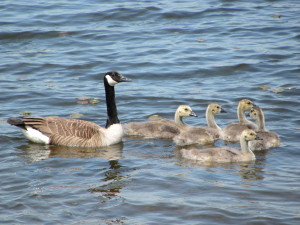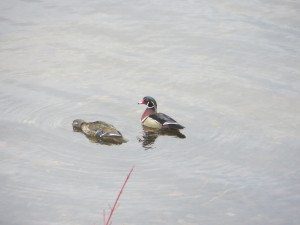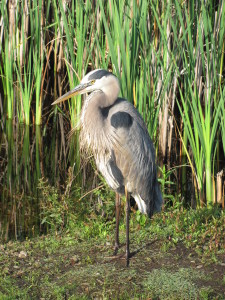by Dana Little, July 2008
Taylor Pond provides essential habitat to a variety of aquatic birds that depend upon its clean and productive waters. Standing by the lake one can count dozens of bird species flying over, diving into, or swimming in the pond. A short hike in any direction away from the pond demonstrates a rapid decline in the numbers and variety of birds. Fifteen species depend on the pond to raise their young. They typically arrive as soon as open water appears around the edges and stay until the pond surface freezes solid.
A pair of Canada Geese in recent years has been nesting on the pond. The male and female will form a pair that lasts for years. They lay 4-7 eggs and then share in raising the young. They often will climb onto lawns that reach all the way to the water. They will forage on sprouting vegetation and insects found on lawns leaving large fecal messes that can be hazardous to people walking on the lawn. Large flocks stop off to rest on the pond during migration north in the spring and south in the fall.
A family of Canada Geese
Four ducks commonly breed on the pond: Wood Duck, American Black Duck, Mallard, and Hooded Merganser. The Black Duck and Mallard stay year round. During the winter they swim in openings of the ice on the pond until they close up, and then they move to the AndroscogginRiver or down to the coast. The Wood Duck and Hooded Merganser slip down to the southern United States for the winter,, but as soon as open water occurs, they reappear. The Wood Ducks can be found in the spring sitting in pairs in large trees around the pond. They like nesting in hollow cavities in old trees, but love it if you provide a nesting box for them. Nests will often contain 15-20 eggs, sometimes from multiple females. The adults and young commonly forage for small invertebrates in the marshes and swamps around Taylor Pond. The secretive Wood Duck, although common, takes an alert observer to spot them before they rapidly fly away when approached. The Hooded Merganser also nests typically in hollow trees or nesting boxes. Up to 35 eggs, which may be laid by several females, have been found in their nests. Hooded Mergansers have been known to lay their eggs in Wood Duck nests. Hooded Mergansers have narrow serrated bills to capture the small fish, frogs and crayfish that form the bulk of their diet. They are secretive birds that are best seen early in the morning or late in the evening diving for their prey in open water. The Black Duck and Mallard will typically lay 8-10 eggs in a grass lined nest usually found in a remote marshy area. Once the young hatch they are commonly seen throughout the day on open water of the pond, the female leading and a long line of young following behind.
Courting Wood Ducks
Common Loon eggs have been found around the pond in the last two years. However, we have not had a successful chick since Audubon volunteers has been monitoring the pond since 1983. I suspect that the lack of breeding success has to do with too many houses along the shore, too much boat traffic, and in the last few years, jet skis that regularly buzz the entire shore line. During the summer a careful search of the pond will usually find 4-6 Common Loons foraging for their favorite food of small fish. They appear tame and are easily approached in a canoe or may suddenly appear close to you while you are swimming.
Great Blue Herons nest in colonies, the closest one being on an island in the AndroscogginRiver. At daybreak the Herons leave their nesting and roosting sites to feed in places like Taylor Pond. During the daytime, Great Blue Herons can often be found standing in shallow water along the shoreline looking for their favorite foods; fish, frogs and crayfish. One day I watched a Great Blue Heron at the end of my dock work for over one-half hour swallowing a foot long prickly perch. The much smaller Green Heron typically nests in thickets in marshy areas. Difficult to find, one usually spots them feeding along natural shorelines, climbing up on overhanging shrub branches, waiting to spear any fish that swim below.
Great Blue Heron
American Bitterns breed in the marshy areas on the side of the pond. Almost never seen, their presence is most commonly noted by their deep booming calls that have an other-worldly nature to them. They feed on small fish, frogs and crustaceans found in the marsh or along the sides of the pond. The Virginia Rail is one of the most difficult-to-spot birds of the pond. They spend all their time in thickets in the middle of the marsh. Their unusual call is commonly heard and once you recognize it you may see them walking about low in the bushes. They are not shy and will parade out in front of you with no apparent fear if you remain still. When we moved into our home here on the pond, one adult led and one adult followed with 10 young in between parading around the moving vans. The young look like black, fluffy ping-pong balls on stilts. Once fully grown they fly off to winter along the southern and gulf coast of the US.
It takes an alert observer to see the common Spotted Sandpipers which are usually seen feeding along the shoreline. Their constant bobbing and black spots on a white belly identify them. They breed in the woods and fields around the pond. They win the prize for aquatic birds flying the furthest as they commonly winter in Chile and Argentina.
Ospreys typically build large stick nests near the water. I have seen no nests near the pond but they can be seen daily catching fish. They hover over the water 30-100 feet and then dive feet first to come up with wriggling perch and bass. The Osprey population plummeted in the 1950’s due to DDT but now they are abundant in Maine. During the winter, they travel down to the coast and as far south as South America. The largest bird found on Taylor Pond, the Bald Eagle, has a wingspan typically over six feet. Their nests can be found on the AndroscogginRiver, but they are regularly seen hunting over the pond. They feed on fish sometimes stolen from Osprey or snatched from the water. They also love to feed on gulls, ducks, and small mammals.


